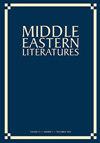Exhausting aesthetic critiques of the authoritarian present in Egyptian literature from Ṣunʿallāh Ibrāhīm to Muḥammad Rabīʿ
IF 0.2
4区 文学
0 LITERATURE
引用次数: 0
Abstract
In this article, I outline a trajectory of aesthetic critique of the authoritarian present in Egypt from Ṣunʿallāh Ibrāhīm’s novellas Tilka al-rāʾiḥa and 67 to Muḥammad Rabīʿ’s ʿUṭārid, from the disappointments and defeats of the Nasser era to the despair of the postrevolutionary present. This trajectory of critique emerges from progressive time’s collapse upon the present and is rooted in aesthetics of exhaustion and disgust. I read Ibrāhīm’s physiological and sexualized aesthetics as political and social critique and show how Rabīʿ intensifies them by charging them with violence. I argue that Rabīʿ’s subsumption of past and future into ʿUṭārid’s apocalyptic hellscape expresses the totalizing nature of authoritarian violence. Lastly, I argue that Rabīʿ’s aestheticization of violence is the culmination of a critical project whose origins I trace back to Ibrāhīm.从Ṣun - allāh Ibrāhīm到Muḥammad,对埃及文学中威权主义的审美批判
在这篇文章中,我概述了对埃及威权主义当下的美学批判的轨迹,从Ṣun - allāh Ibrāhīm的中篇小说Tilka al- rahu - iḥa和67到Muḥammad rabi - ahu - s - Uṭārid,从纳赛尔时代的失望和失败到后革命时代的绝望。这种批判的轨迹源于进步时代对当下的崩溃,植根于疲惫和厌恶的美学。我把Ibrāhīm的生理和性别化美学作为政治和社会批判来阅读,并展示了拉卜是如何通过指责他们使用暴力来强化他们的。我认为,拉卜将过去和未来纳入Uṭārid的启示录地狱景观,表达了专制暴力的总体性质。最后,我认为,拉卜对暴力的审美化是一个关键项目的高潮,我可以追溯到Ibrāhīm。
本文章由计算机程序翻译,如有差异,请以英文原文为准。
求助全文
约1分钟内获得全文
求助全文

 求助内容:
求助内容: 应助结果提醒方式:
应助结果提醒方式:


